The Bible app niche is booming.

If you’ve been in the consumer app industry or close to app studios, we bet you know someone who just built a Bible app.
It seems like the space has been heading toward total saturation for months now, yet every week new apps launch on the App Store and start making money like it’s easy.
We’ve covered many and noticed what they have in common (and what sets them apart).

Here’s a competitive landscape of the most interesting and viral strategies in the Bible niche:
Solo Founders
Prayer Project
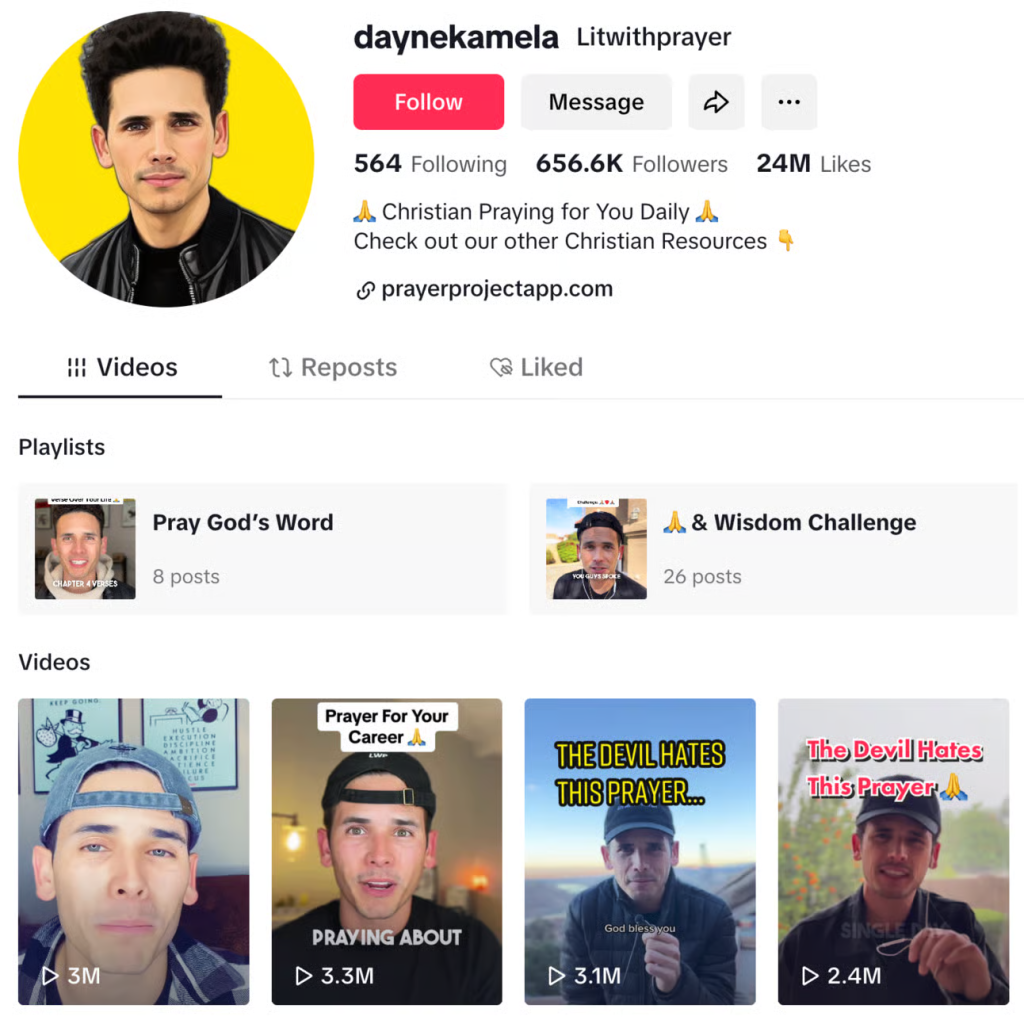
Dayne Kamela started posting on TikTok in 2020. If you look at his earlier TikTok videos, you’ll see that he was using it as a personal account (no marketing, no growth-optimized formats).
He uploaded pretty actively from January to March 2020, but then he stopped, probably after struggling to get even a single video outside the 300-views jail.
He disappears until June 2020, then comes back with a new video where he shares his struggles with COVID. It wasn’t the first time he made a video sharing personal details, but after that, his videos started to carry a more hopeful undertone.
100 videos later, he gets his first viral hit.
He never stops after that and keeps posting the same kind of content not only on TikTok but also on Instagram Reels and YouTube.
tt@daynekamela — 106,200,000 views, 27.81% engagement rate
ig@litwithprayer — 132,400,000 views, 13.84% engagement rate
yt@litwithprayer — 30,700,000 views, 22.84% engagement rate
Riding the wave of all that virality, Dayne decided to build a prayer app at the end of 2024: Prayer Project (a reminder to pray).
The app launched on April 6. Right now, it seems to be low on both downloads and revenue. This struggle with conversion likely ties back to the way Dayne structures his videos.
Probably out of fear of losing his personal audience’s trust, he only mentions the app in about 1 in every 10 posts.
Dayne’s best format
He always shows his face as he speaks to the camera.
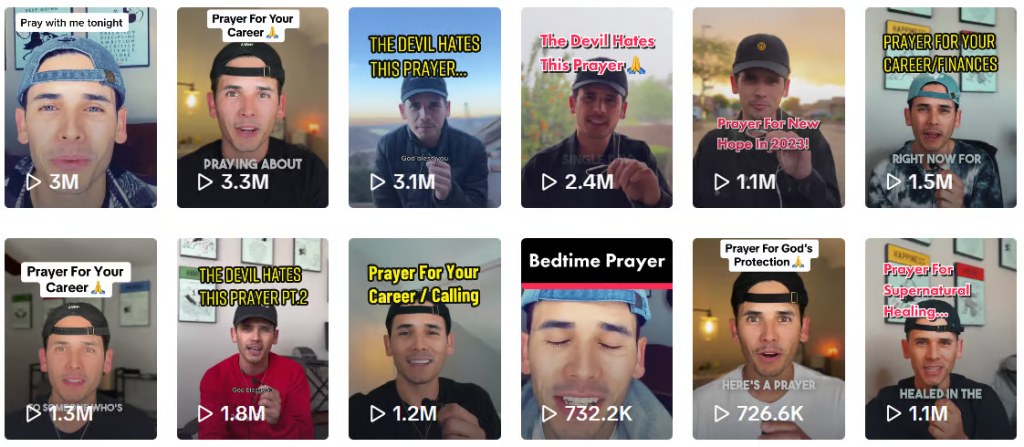
Once he gets a viral video, he just keeps repeating the same over and over, with slight variations (emoji, add-ons, etc):
| Theme | Video Count | Total Views |
| “Prayer For Your Career” | 25 | 7,179,622 |
| “Pray This Prayer Before Bed” | 41 | 1,469,221 |
| “Prayer For God To (…)” | 37 | 1,096,892 |
| “Here’s a Prayer (…) | 11 | 929,986 |
| “Pray Over Your Finances” | 8 | 836,700 |
| “ A Powerful Prayer For (…)” | 8 | 829,135 |
| “Prayer For a Blessed (…)” | 32 | 754,922 |
| “Pray with me (…)” | 28 | 492,315 |
| “Prayer For Healing (…)” | 24 | 458,508 |
| “Prayer For the New Week (…)” | 28 | 392,376 |
| “Prayer Over Your Mind” | 18 | 359,864 |
| “The Devil Hates This Prayer” (and similar) | 9 | 348,302 |
| “Prayer For Your Mental Health” | 15 | 267,334 |
| “Day 23 of 31 Prayer For (…)” | 25 | 259,294 |
| “Prayer For Your Family” | 8 | 251,600 |
| “Prayer For (…) in 2025” | 9 | 157,629 |
| “Prayer For Your Friends” | 4 | 65,900 |
Bible AI
There’s a similar founder story behind the app Bible AI.
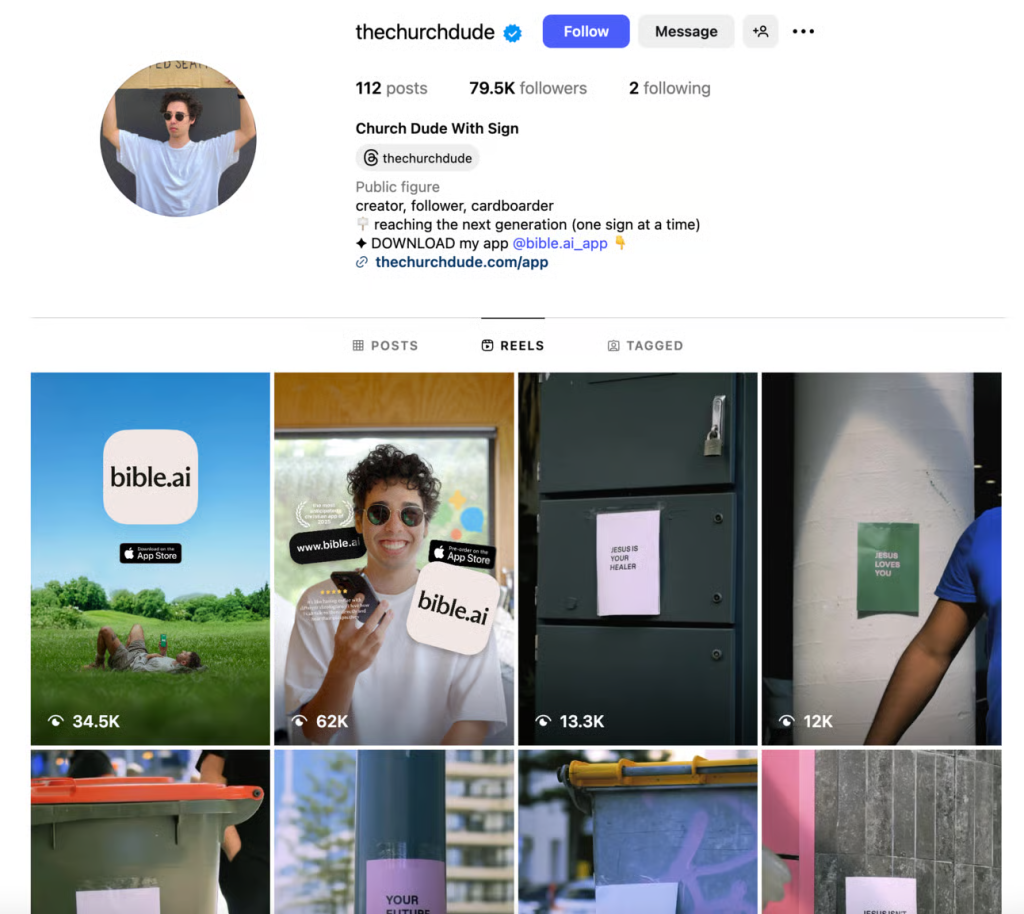
It was released in February by a guy who also spent months building a personal brand on Instagram Reels and TikTok.
Leio McLaren, the 26-year-old founder, followed a similar path, but he had a clear strategy in mind. He took a viral format that was trending at the time and brought it to ChristianTok.
“Church Dude with a Sign” was his format the entire time. He scaled his Instagram and TikTok accounts to 934,200 views, launched one branded account on each platform, then disappeared completely. The last time he posted was in April, on tt@thechurchdude.
Bible AI never really took off (1,000 downloads in the past 30 days).
Shame, when you own bible(dot)ai.
The Battle for Conversion
A lot of content-to-commerce strategies like these two suffer from the same struggle: turning views into long-term conversions.
In the short term, your audience will try anything you launch. You’d better hope that your app is sticky.
Then you have to consistently pump out content, multiple times a day, to keep the momentum going.
Often, creators are too shy about pushing their products when they could do it way more. Viewers are used to being sold something and won’t mind as long as it’s in the niche.
We’re gonna look at some players who managed to scale their bible apps to > 20K monthly downloads:
Small & Medium Apps
Pray Screen
- 30,000 downloads last month
- $20,000 revenue last month
- Launch date: 15/11/2024
- Total views: 14,958,093 (TikTok only)
Pray Screen found a sub-niche within ChristianTok, blending prayer and productivity. It’s built to keep you disciplined in your prayers and biblical studies.
They were very bold in trying out new formats and had a breakthrough that started shaping the strategies of multiple other apps. Not only in the Bible niche (we’ll see that next), but across many others, too.
Their TikTok account, tt@prayscreenio, reached 13,200,000 views by riding one specific format exclusively:
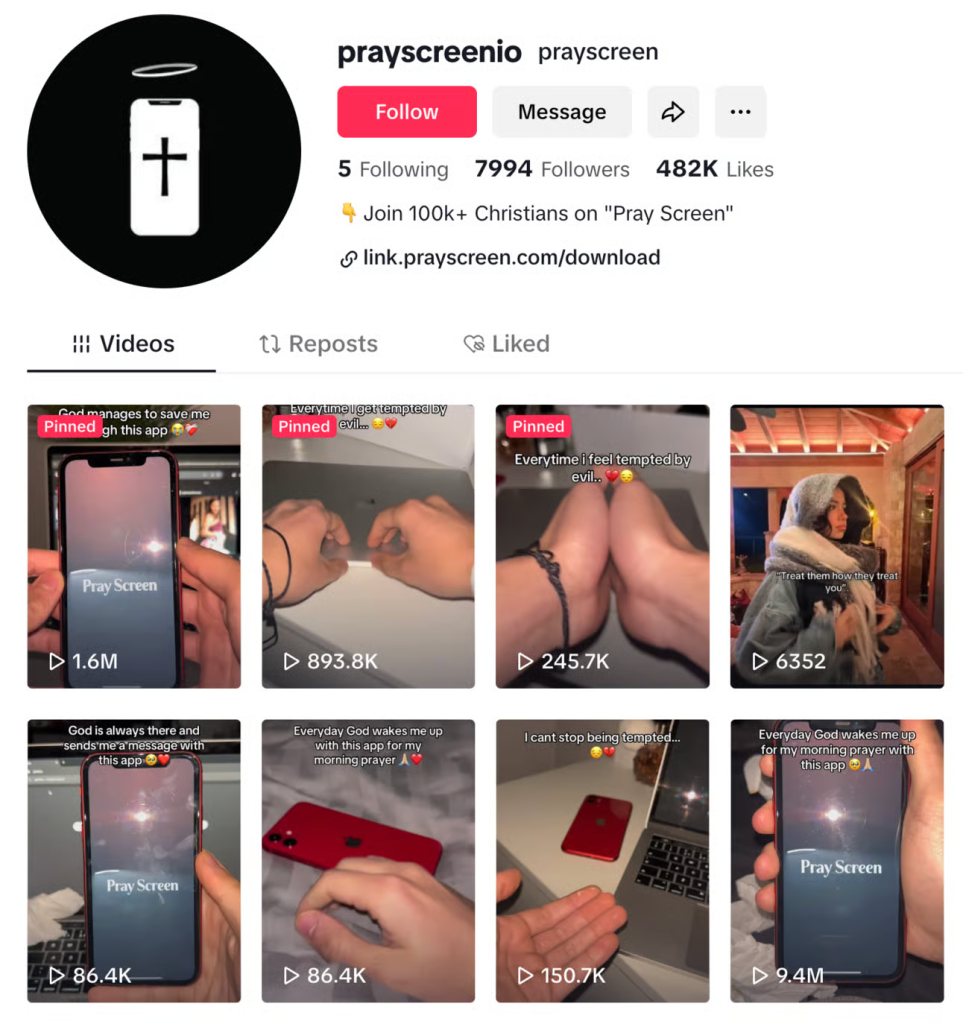
- Faceless recording of a laptop screen, with a guy reaching for hand lotion
- Text hook implying temptation and sinning
- New text introducing the app (“this app saved me”)
- Hands drop the lotion and grab the phone (showing the app on-screen)
Notice the difference between this format and the previous ones, in terms of conversion?
- It targets a real audience. P*rn addiction is a massive issue among young teens and adults
- It shows the app in action, tying it directly to the problem within the first few seconds
Their best-performing videos are between 10–15 seconds long.
Faithy
- 80,000 downloads last month
- $20,000 revenue last month
- Launch date: 23/06/2024
- Total views: 4,535,861 (TikTok only)
Faithy was a slow burn. On TikTok, it took them months to get their first high-performing video. However, they always had a clear and streamlined strategy in place. Allowing them to test different formats until one finally hits.
They’re running 47 different accounts. Each one focuses on a specific format. Can you guess the first one?
Temptation format (tt@juan.faithy)

This is their most viral account. They replicated the exact same format as Pray Screen, but in Spanish. Videos start with a “male” opening his laptop (faceless), then closing it and reaching for the Faithy App instead.
What’s interesting is that this format doesn’t align with their use case as well as it does for Pray Screen. Faithy isn’t focused on discipline or prayer streaks. For them, it still works like gold, and it’s driving conversions nonetheless.
This proves that content-market-fit is real. If a content type is working, it’ll continue working (in the timespan it lives in, which is way shorter than the product-market-fit timeline).
Faceless slideshows (tt@faithy.praise)
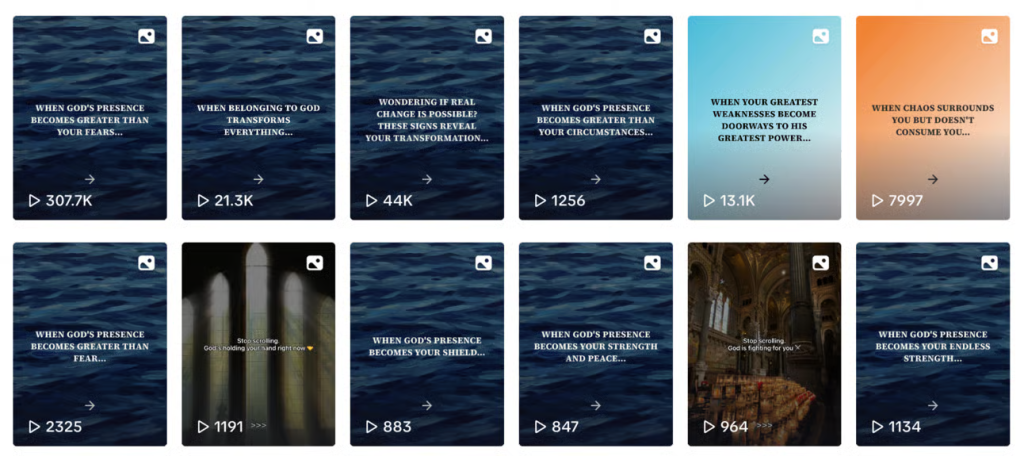
This is a branded account using carousel posts, all with the same design and a consistent text hook style:
“When God’s presence becomes greater (…)”
“Wondering if real change is possible?(…)”
…
In every slideshow, the app appears on slide #2 with a screenshot of a quote from inside the app. You can clearly read the name of the app as well.
Girl creator talking to camera (tt@daniellegofaith)
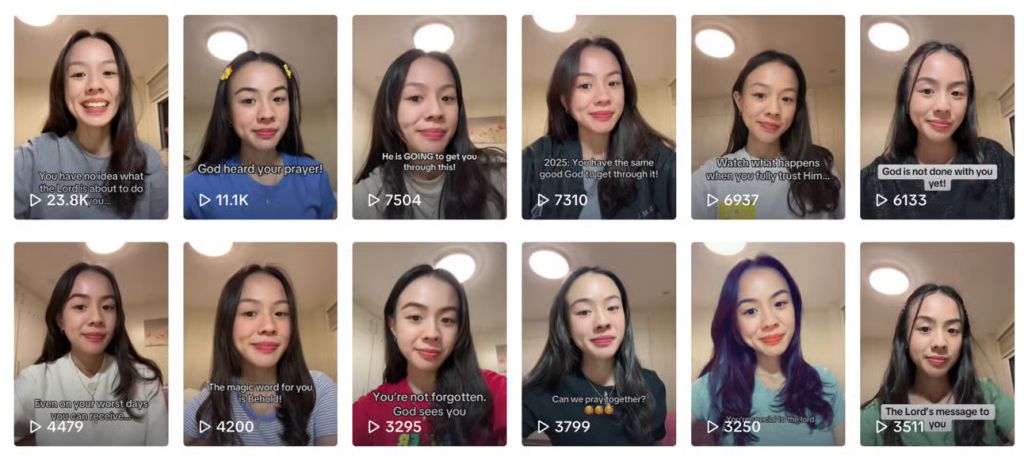
This account remains on the lower view side, but it has one of the highest engagement rates in the entire collection.
Longer form usually correlates with higher & more valuable engagement.
It’s just a girl speaking directly to the camera. She starts with a text hook like:
- “You have no idea what the Lord is about to do for you…”
- “God heard your prayer”
- “HE is going to get you through this!!”
…
Then she shows a (random) quote directly from the app, with Faithy AI appearing on-screen again.
Because this account leans much more into biblical and religious messaging, it sparks significantly more engagement than the others.
26.29% engagement rate. All comments look like:
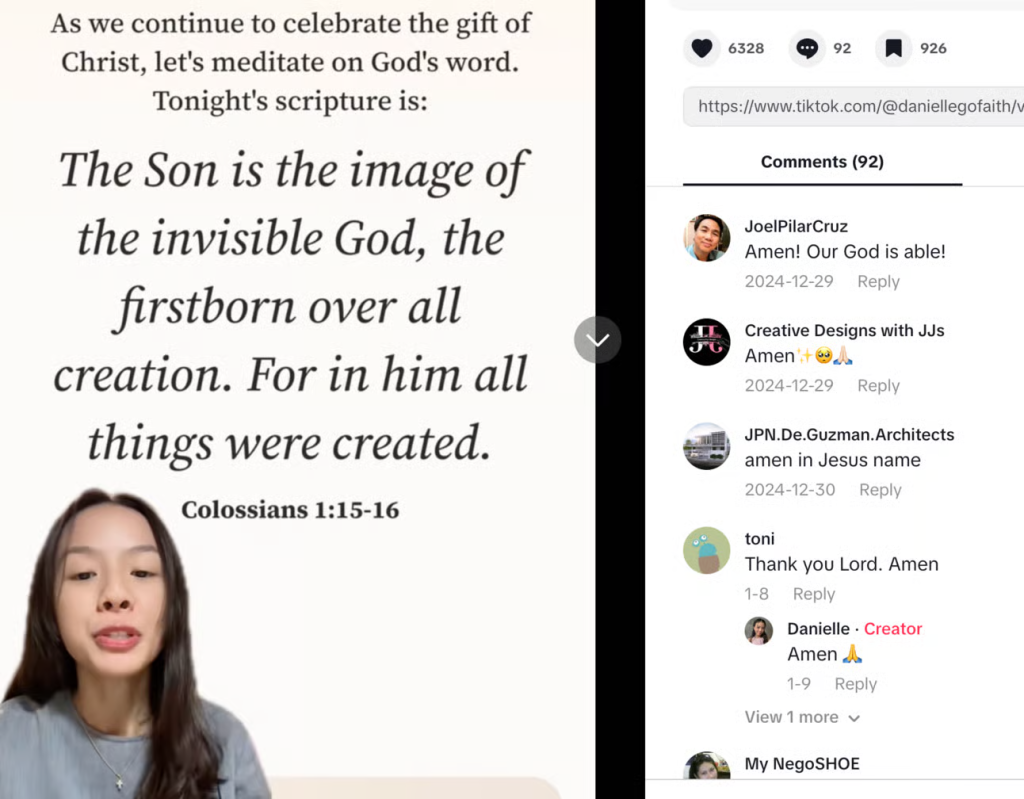
—
Next week, we’re sending a part two of this competitive landscape with the breakdown on all the major players in this niche. Stay tuned for that.
Until then, may the App Store Holy Spirit light your path (to $1M mrr),
The Social Growth Engineers Team
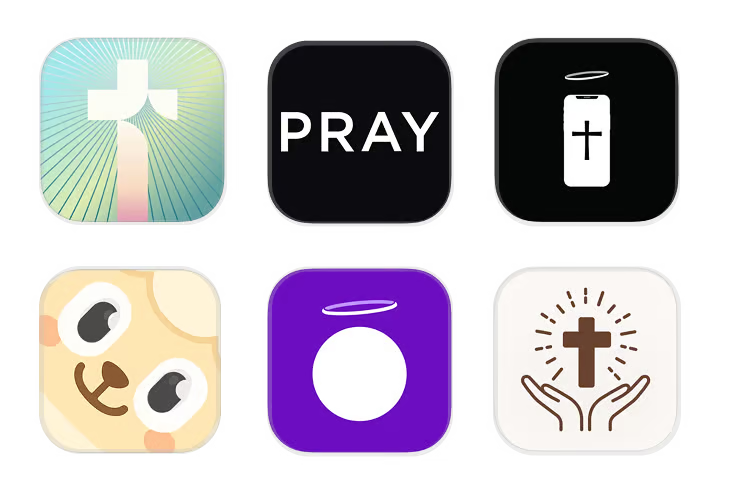
Leave a Reply